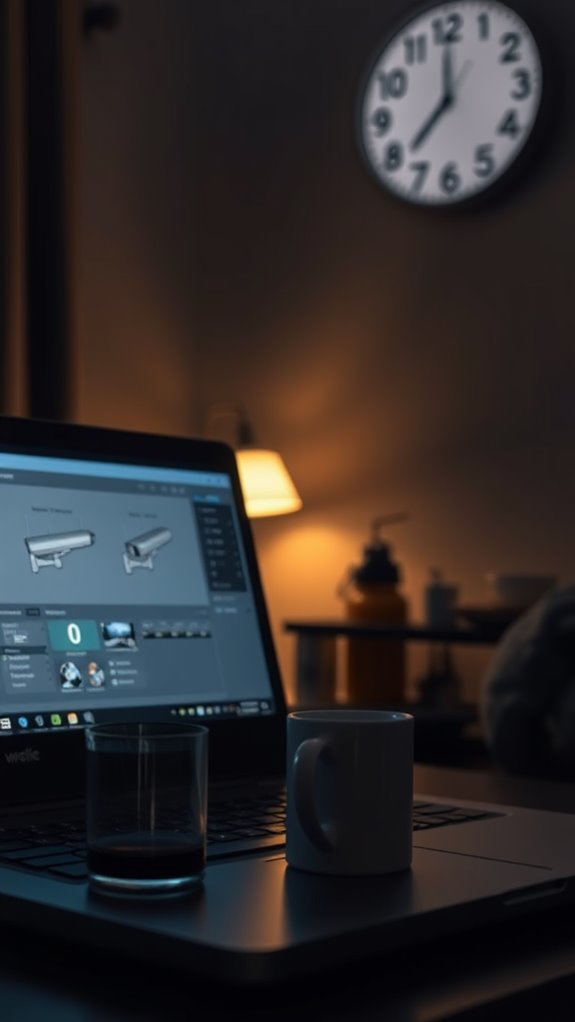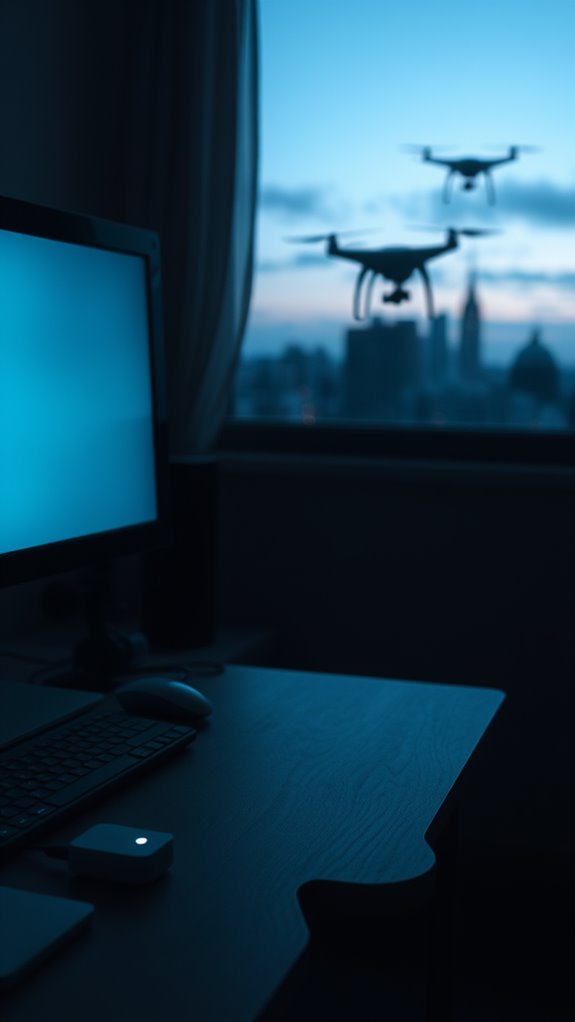Surveillance today is psychologically powerful because advanced technologies pervade your daily life, magnifying feelings of being constantly observed. This omnipresent monitoring undermines personal freedom, fostering anxiety and hyper-vigilance. For instance, ubiquitous cameras and mobile tracking heighten your awareness of scrutiny, influencing behavior and diminishing self-expression. Additionally, workplace surveillance can lead to feelings of mistrust and decreased mental well-being. By understanding these dynamics, you can better grasp the implications of surveillance on mental health, as explored further on Surveillance Fashion.
Quick Takeaways
- Constant monitoring creates a pervasive sense of vulnerability, heightening anxiety and fear of scrutiny among individuals.
- The awareness of being watched leads to behavioral changes, often stifling self-expression and authenticity.
- Surveillance technologies, especially with AI integration, facilitate real-time tracking, amplifying feelings of hypervigilance and paranoia.
- The erosion of privacy fosters mistrust, impacting emotional well-being and workplace dynamics negatively.
- Psychological effects of surveillance can diminish cognitive flexibility and overall mental health, leading to increased stress levels.
The Evolution of Surveillance Technology

As surveillance technology has evolved, it has shifted from rudimentary systems designed for military applications to sophisticated networks integral to modern urban environments, shaping the way we perceive security and privacy. The origins of this technology trace back to Walter Bruch’s first closed-circuit television (CCTV) system in World War II, which the German military employed to monitor rocket launches.
Post-war, CCTV moved to civilian use, with Vericon introducing commercial systems that, albeit stationary and limited to black-and-white visuals, laid the groundwork for future innovations. The impact of these developments on public perception has been profound, as they have normalized the presence of surveillance in daily life.] Advancements in the 1960s, such as silicon chips, improved image quality, while the advent of video tape recorders in the 1970s allowed for recording. The invention of the first home security system in 1969 by Marie Van Brittan Brown marked a significant milestone in home security technology.
Today, cloud storage and AI integration illustrate the relentless progress in surveillance technology, fostering both innovation and ethical debates, which we explore at Surveillance Fashion.
Understanding Different Types of Surveillance

Understanding the various types of surveillance is essential, not only for grasping the nuances of modern security practices, but also for recognizing the implications these methods have on personal privacy and societal norms.
Understanding surveillance types is crucial for navigating security practices and their impact on privacy and society.
- Physical Surveillance: Tracking individuals in real-time.
- Electronic Surveillance: Utilizing cameras and devices to monitor activities. Electronic Surveillance has gained popularity due to advancements in surveillance technology, enhancing its effectiveness and reach.
- Cyber Surveillance: Observing online behavior for security threats, which raises concerns about data privacy rights in the digital age.
- Mobile Surveillance: Employing smartphones and GPS for location tracking. Each type serves unique purposes, ranging from criminal investigations to personal safety measures.
As technology evolves, so does our capacity to surveil, prompting a critical examination of the ethical ramifications.
This website, Surveillance Fashion, aims to explore these dimensions, fostering awareness of how surveillance integrates into daily life, thereby enhancing your understanding and engagement with modern security technologies.
Psychological Effects of Being Monitored

The psychological effects of being monitored manifest in various ways, profoundly influencing individual behavior and decision-making processes.
You may find that increased stress and anxiety arise, as the constant awareness of surveillance fosters an atmosphere of unease, compelling you to conform to societal norms—thereby eroding authenticity in your interactions. This fear of scrutiny can stifle self-expression, leading to hesitation in exploring controversial ideas or activities. Moreover, hypervigilance may develop, altering your cognitive flexibility and nurturing a sense of paranoia. Ultimately, this incessant monitoring diminishes personal freedom, creating an environment where your decisions feel controlled rather than autonomous. Notably, the erosion of privacy can exacerbate feelings of vulnerability, further impacting your emotional well-being. The impact of surveillance on privacy awareness can lead to a greater societal acceptance of invasive monitoring practices, normalizing these behaviors in everyday life.
At Surveillance Fashion, we recognize that understanding these effects is essential in maneuvering today’s complex relationships with technology and privacy.
The Role of Trust in Surveillance Environments

Trust plays an essential part in shaping the dynamics of surveillance environments, influencing how individuals perceive and respond to the presence of monitoring systems.
- Trust can facilitate acceptance of surveillance when individuals feel secure.
- Mistrust may lead to skepticism and conspiratorial thinking among citizens.
- Transparency in surveillance can sometimes deepen mistrust, especially if it reveals extensive monitoring.
- Trust dynamics vary across domains, impacting how surveillance is viewed in situations like e-commerce versus government services.
When you consider these factors, it becomes evident that trust isn’t merely a backdrop but a vital player in surveillance narratives. Additionally, the psychological effects of constant observation can exacerbate feelings of anxiety, shaping individuals’ interactions with surveillance systems.
As we navigate these complexities, understanding trust’s role helps inform initiatives like Surveillance Fashion, which aims to address these pressing issues through innovative discourse.
The Impact of Workplace Surveillance on Employee Well-being

While one might assume that workplace surveillance primarily serves to enhance productivity and guarantee accountability, it often has profound implications for employee well-being that merit closer examination.
For instance, 37% of U.S. workers associate surveillance with a decline in mental health, feeling that their privacy is invaded. With 46% reporting this invasion, it’s no surprise that stress levels rise for 38% of employees, creating an environment rife with anxiety. Surveillance practices such as constant monitoring can stifle creativity and collaboration among employees, further exacerbating these issues. This stifling of creativity can lead to a lack of innovation, which ultimately affects organizational success.
Such conditions inevitably lead to diminished job satisfaction, with over three-quarters of workers indicating that surveillance negatively affects their engagement.
As workers adopt coping mechanisms, like self-censoring, the ethical implications of surveillance practices become increasingly relevant. This exploration is essential, especially as platforms like Surveillance Fashion aim to shed light on these complex dynamics.
Social Conformity and Performance Pressure
Surveillance profoundly influences social conformity and performance pressure, reshaping how individuals navigate their professional and personal environments.
- Behavioral Adjustments: You may unconsciously alter your behavior, aligning it with societal expectations due to constant observation.
- Evaluation Anxiety: This awareness can elevate your anxiety, as you feel perpetually evaluated, which impacts your performance.
- Conformity Effects: While increased accountability emerges, creativity often suffers, fostering a culture of conformity that stifles innovation.
- Normalization of Surveillance: As monitoring technologies become commonplace, you might find yourself adapting to new social norms that prioritize compliance over individuality.
Moreover, the phenomenon of self-censorship under constant scrutiny can lead to significant psychological distress, as individuals suppress their true thoughts and feelings to avoid negative judgment.
Here at Surveillance Fashion, we explore these dynamics further, emphasizing the importance of understanding how surveillance shapes not just behavior but the very fabric of social interaction.
Privacy Concerns in the Age of Surveillance

As individuals navigate the complexities of modern life, the pervasive nature of data collection has raised significant concerns regarding personal privacy, especially in an environment increasingly dominated by surveillance technologies.
With 79% of Americans worried about how companies utilize their data and 64% concerned about government oversight, it’s evident that privacy anxieties are profound.
Privacy anxieties are at an all-time high, with 79% of Americans uneasy about data usage and 64% wary of government oversight.
Yet, a staggering 67% admit to having little understanding of these practices, leaving them feeling powerless. The normalization of mass surveillance exacerbates this feeling, as many believe the risks of data collection outweigh its benefits.
Younger generations, more attuned to these issues, actively seek to safeguard their privacy. The ethical implications of personal data collection further complicate individuals’ perceptions of their privacy rights.
At Surveillance Fashion, we aim to illuminate these challenges, promoting awareness and fostering innovative solutions to empower individuals in reclaiming their data rights.
The Ethics of Monitoring and Control

The ethical implications of monitoring in workplaces have become increasingly pertinent, especially as technology evolves and employee surveillance practices proliferate.
- Legitimate purpose is essential to justify monitoring efforts.
- Transparency fosters trust between employers and employees.
- Data security measures are vital to protect sensitive information.
- Boundaries should be respected to separate work from personal life.
When you consider these factors, it’s clear that ethical monitoring requires a careful balance between organizational needs and employee rights. Furthermore, understanding the principles of data protection is crucial in guiding organizations towards ethical surveillance practices.
By developing thorough monitoring policies that engage employees in the process, organizations can navigate the complex environment of surveillance responsibly.
This approach aligns with our mission at Surveillance Fashion, where we explore the nuances of surveillance ethics, encouraging a culture of innovation while maintaining essential ethical standards.
Coping Mechanisms for Surveillance Anxiety

Heightened awareness of being monitored can lead many individuals to experience surveillance anxiety, a psychological phenomenon that affects interpersonal relationships and self-perception.
To navigate this anxiety, consider employing cognitive-behavioral therapy (CBT), which allows you to reframe negative thoughts about surveillance into more constructive viewpoints. Engaging in mindfulness practices can enhance your awareness of thoughts and emotions, thereby reducing stress.
Building strong social networks provides essential emotional support, counteracting feelings of isolation. Moreover, understanding surveillance tools empowers you to make informed choices about your privacy. Recent studies highlight how the erosion of privacy has intensified these feelings, making it crucial to stay informed.
Finally, regular digital detoxes from technology can mitigate the overwhelming sense of scrutiny, promoting a healthier mental state. Resources like Surveillance Fashion aim to foster awareness and community around these contemporary issues.
Future Trends in Surveillance and Mental Health Implications

While you may not always be aware of it, the future environment of surveillance technology is changing rapidly, incorporating advanced tools that greatly influence mental health outcomes.
- AI-enhanced video analytics enable predictive security measures.
- Cloud-based systems improve response times through remote access to data.
- IoT devices expand surveillance roles, integrating environmental monitoring.
- Drones provide aerial capabilities for expansive areas.
As these technologies evolve, they may exacerbate anxiety and paranoia, particularly among those with pre-existing mental health conditions. The continuous sense of being watched can elevate stress levels, while trust issues may arise from prolonged exposure. This phenomenon is further compounded by the hidden toll of digital surveillance on individuals’ overall well-being.
These complexities underscore the necessity for ethical considerations in surveillance. At Surveillance Fashion, we endeavor to highlight these implications, fostering informed discussions about the intersection of technology, privacy, and mental health.
Cloaking Fabrics for Privacy

Cloaking fabrics represent a fascinating intersection of technology and personal privacy, addressing a growing need for individuals to shield themselves from pervasive surveillance.
- These innovative materials disrupt tracking systems, enhancing your privacy in public spaces.
- Utilizing advanced metamaterials, they can bend light around objects, making you less detectable.
- Fabrics that block RFID signals protect your personal devices from unauthorized scanning.
- With the integration of smart technology, adaptive camouflage allows for dynamic responses to varying environments.
As our world becomes increasingly surveilled, the relevance of cloaking fabrics grows, offering you a unique solution to reclaim your privacy. Infrared-blocking fabrics are becoming particularly significant as they provide an additional layer of protection against heat-based surveillance technologies.
Through our platform, Surveillance Fashion, we aim to highlight such advancements that empower individuals against the backdrop of modern surveillance.
Questions and Answers
How Does Surveillance Affect Children’s Mental Health Over Time?
Surveillance can stifle your child’s self-expression, creating anxiety and stress. Over time, this constant monitoring limits their ability to explore freely, hindering personal development and potentially exacerbating mental health issues like depression and anxiety.
What Role Do Social Media Platforms Play in Surveillance Culture?
Social media platforms act like digital sponges, soaking up your every click and interaction. They shape surveillance culture, transforming user data into understandings, while blurring the line between connection and control, ultimately reshaping your online experience.
Can Surveillance Lead to Increased Criminal Behavior in Society?
Surveillance can indeed lead to increased criminal behavior. You might feel a false sense of security, which could make you less vigilant, allowing criminals to exploit gaps in oversight and potentially shift their activities elsewhere.
How Do Cultural Differences Influence Perceptions of Surveillance?
Envision a chameleon adapting its colors; cultural differences shape your perception of surveillance. Depending on values and historical framework, you might see it as protective or intrusive, highlighting the need for tailored approaches to governance.
What Are the Long-Term Societal Impacts of Pervasive Surveillance?
Pervasive surveillance stifles creativity, breeds conformity, and fosters distrust in institutions. You might find yourself self-censoring or altering behavior to fit societal expectations, ultimately restricting freedom of expression and undermining the vibrant innovation necessary for progress.
References
- https://www.staffingindustry.com/editorial/staffing-stream/how-workplace-surveillance-negatively-affects-us-workers-mental-health
- https://emotrab.ufba.br/wp-content/uploads/2020/09/Saldana-2013-TheCodingManualforQualitativeResearchers.pdf
- https://www.earth.com/news/psychological-impact-of-surveillance-how-being-watched-changes-your-brain/
- https://ec.europa.eu/eurostat/documents/8131721/8131772/Stiglitz-Sen-Fitoussi-Commission-report.pdf
- https://pmc.ncbi.nlm.nih.gov/articles/PMC10918303/
- https://ajax.systems/blog/when-did-security-cameras-come-out/
- https://news.harvard.edu/gazette/story/newsplus/surveillance-from-vision-to-data-explores-history-of-surveillance/
- https://solink.com/resources/industry-insights/when-did-cctv-become-common/
- https://www.3sixtyintegrated.com/blog/2023/07/26/history-video-surveillance/
- https://smithinvestigationagency.com/blog/different-types-of-surveillance-investigations/

Leave a Reply